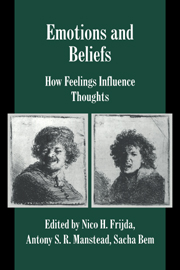Book contents
- Frontmatter
- Contents
- Contributors
- 1 The influence of emotions on beliefs
- 2 Feeling is believing: Some affective influences on belief
- 3 Beliefs through emotions
- 4 The sentiments and beliefs of distributed cognition
- 5 Feeling is believing? The role of processing strategies in mediating affective influences on beliefs
- 6 The formation of beliefs at the interface of affective and cognitive processes
- 7 Anxiety, cognitive biases, and beliefs
- 8 A cognitive dissonance theory perspective on the role of emotion in the maintenance and change of beliefs and attitudes
- 9 Relationship beliefs and emotion: Reciprocal effects
- Index of authors
- Index of subjects
- Studies in Emotion and Social Interaction
7 - Anxiety, cognitive biases, and beliefs
Published online by Cambridge University Press: 10 March 2010
- Frontmatter
- Contents
- Contributors
- 1 The influence of emotions on beliefs
- 2 Feeling is believing: Some affective influences on belief
- 3 Beliefs through emotions
- 4 The sentiments and beliefs of distributed cognition
- 5 Feeling is believing? The role of processing strategies in mediating affective influences on beliefs
- 6 The formation of beliefs at the interface of affective and cognitive processes
- 7 Anxiety, cognitive biases, and beliefs
- 8 A cognitive dissonance theory perspective on the role of emotion in the maintenance and change of beliefs and attitudes
- 9 Relationship beliefs and emotion: Reciprocal effects
- Index of authors
- Index of subjects
- Studies in Emotion and Social Interaction
Summary
Introduction
This introductory section will indicate the scope of this chapter, which inevitably is less broad than a systematic examination of the general notion that emotions influence beliefs. Most of my research of relevance to this notion has involved only one emotion, which is anxiety. Accordingly, the central focus of this chapter will be on the interface between anxiety and cognition. What appears to be true of the relationship between anxiety and cognition may or may not be true of other emotions.
The main problem that is apparent when one considers some of the theoretical approaches to anxiety (or emotion generally) and cognition is that they are far more concerned with the impact of cognitive structures (e.g., beliefs; schemas) and cognitive processes (e.g., cognitive appraisal; cognitive biases) on emotion and on emotional experience than with the opposite direction of causality from emotion to cognitive processes and structures. More specifically, theorists such as Lazarus (1991), Beck and Clark (1988), and Eysenck (1992,1997) have incorporated the notion that there are bi-directional effects between beliefs and cognitive processes on the one hand and emotion on the other hand, but their main research emphasis has been on the impact of beliefs and cognitive processes on emotion.
In spite of the difficulties posed by the above considerations, a systematic attempt will be made to relate theory and research to the issue of the impact of anxiety on beliefs. However, it should be emphasized at the start that there is a very long way to go before this issue is fully understood.
- Type
- Chapter
- Information
- Emotions and BeliefsHow Feelings Influence Thoughts, pp. 171 - 184Publisher: Cambridge University PressPrint publication year: 2000
- 8
- Cited by



